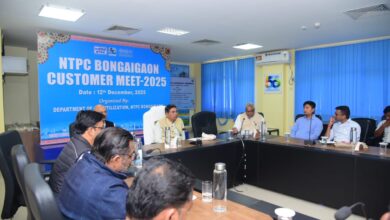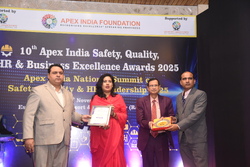Jharia Master Plan : Coal Ministry Efforts Bring Down Surface Fire Identified From 77 To 27 Sites
Carries out successful relocation and rehabilitation of affected families

Coal mines in Jharia Coalfield dates back to 1916 when the first incidence of fire was reported. Since then, a number of fires have occurred within the overburden debris. Prior to nationalization, these mines were privately owned and operated with a profit-driven approach and mining methods were unscientific with least concern for safety, conservation and the environment. This practice has resulted in severe land degradation, subsidence, coal mine fires and other socio-environmental problems.
After nationalization, Polish team & Indian experts were appointed in 1978 to study the Jharia coal fire predicament. According to the investigations,77fires across 41 collieries of BCCL were identified. In 1996, Govt of India has constituted a High-Power Committee under the chairmanship of Secretary, Ministry of Coal to review the problems of fire and subsidence in JCF. To address these fires and rehabilitate the residents in vicinity two masterplans were formulated in 1999,later revised and updated in 2004 which was based on enhanced fire dealing efforts of BCCL and Ministry of Coal. This comprehensive Master Plan cover two aspects. Firstly, focus on with fire management, which includes identification of fire areas, selection of technologies to deal with the fires, prioritizing the implementation and assessment of tentative fund requirement and secondly Rehabilitation & Resettlement of the affected people due to fire & subsidence including identification of affected sites, resettlement sites and assessment of tentative fund requirement.

Finally, Jharia Master Plan (JMP) for dealing with Fire, Subsidence and Rehabilitation was approved on 12th August 2009 by Govt. of India with implementation period of 10 years and pre-implementation period of two years with estimated investment of Rs. 7112.11 crores. The Masterplan identified 595 sites that needed to be rehabilitated, covering an area of 25.70 square kilometers.
The Ministry of Coal has been closely monitoring fire incidents and rehabilitation efforts. High-Power Central Committee (HPCC) meetings, chaired by the Secretary, Ministry of Coal, were held to oversee the progress of the Jharia Master Plan. The fire-affected area has significantly reduced from 77 sites (Pre-Nationalization) to 67 sites (As per Jharia Master Plan,2009) covering 17.32 sq. km to 27 sites covering 1.8 sq. km according to surveys conducted in 2021. So far, approx. 21 High power committee meetings have been taken place. BCCL undertook significant efforts to combat the fires, implementing 27 fire projects that harnessed the best available technology. These efforts included techniques like surface sealing, digging, trenching, infusion of inert gas, and remote sand-bentonite mixture flushing.
According to JMP, housing has emerged as a major component in rehabilitation, with due consideration given to skill development, employment opportunities, and inclusive shifting. Three categories of the population need rehabilitation: legal title holders, non-legal title holders, and families of BCCL employees. Initially, BCCL was to construct 25,000 houses, but due to superannuation and other reasons, the number of required houses reduced to 15,713. BCCL has constructed 11,798 houses till date, and the remaining are under construction. Out of the 15,713 houses, 8,000 houses will be allotted by JRDA to legal title holder families.
While facing numerous challenges in the implementation of the approved Jharia Master Plan, the Ministry of Coal has displayed firm determination and dedication to tackle them head-on. The complexities ranged from technological limitations in assessing underground fires to the perception among affected families that the plan was aimed at acquiring land for coal mining rather than addressing fire and subsidence hazards. Non-acceptance of the rehabilitation package by land owners, absence of a legal framework for land rights transfer to JRDA complicated the process of rehabilitation.
Despite the array of challenges, the Ministry of Coal worked tirelessly to overcome each obstacle and demonstrated remarkable resilience and achieved significant progress. Furthermore, to address resettlement and rehabilitation needs, extensive planning was undertaken, including the diversion of rails, roads, and surface infrastructure. Detailed project reports (DPRs) were prepared to support affected families, with significant progress made in constructing new houses. Substantial funds were allocated for fire management and rehabilitation, emphasizing the importance of these efforts.
Even after the expiration of the Jharia Master Plan in August 2021, the Ministry of Coal continues to review the progression of activities undertaken by BCCL & JRDA on a biweekly and monthly basis. Additionally, the Ministry is continuing to fund ongoing projects that were undertaken during the expiration of the Jharia Master Plan for fire dousing and rehabilitation, in consultation and coordination with the State Government. The efforts of the Ministry of Coal in tackling the fires, resettling the affected families, and ensuring the sustainable extraction of coal have laid the groundwork for a brighter future.
A committee was constituted in 2022 headed by Secretary Coal, to review the Jharia Master Plan with a focus on extinguishing fires, rehabilitating affected families, and proposing a way forward. This committee formulated an action plan, which was subsequently approved by the Committee of Secretaries. During the Committee of Secretaries meeting, several key decisions were made, mainly regarding the cut-off date. Cash compensation will be offered instead of further house construction, and ownership rights will be granted to the affected families. Additionally, essential amenities such as schools, dispensaries, roads, water supply, and sanitation facilities will be developed for houses that are already constructed or currently under construction
Amidst the ongoing rehabilitation efforts, the projection for coal evacuation remained a priority. Out of the estimated 107MT of coal in 16 locations, ~43 MT had been extracted by June 2023, value of which is about Rs. 14,000 Crores.
In the face of formidable challenges, the Ministry of Coal remained resolute and committed to bringing about positive changes in Jharia. The resettlement and rehabilitation work are being conducted in well-organized phases. Initially, landowners will receive compensation for their land or they are allocated suitable housing alternatives. After this, land acquisition for coal extraction will be undertaken, and once the coal extraction is successfully completed in the entire area, it will be scientifically closed down. Subsequently, the entire region will undergo the process of de-coaling.
The Coal Ministry’s commitment and hard work have yielded significant advancements, including a notable reduction in fire sites, successful relocation and rehabilitation of affected families, and steady progress in coal extraction. These accomplishments stand as a testament to the Ministry’s proactive stance and unwavering determination to secure a brighter and safer future for the people of Jharia. The Ministry’s efforts have played a pivotal role in transforming a once-troubled region into a symbol of progress and prosperity.




